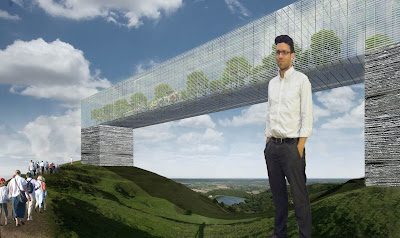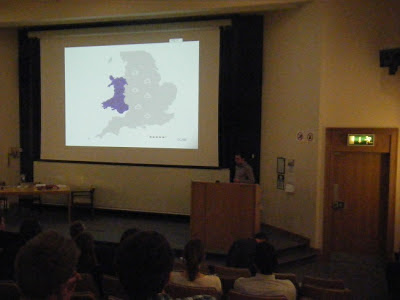I found this week’s press coverage* of people defecating in
the streets of Swansea, and the subsequent discussion of it via social media, depressing for a number of reasons. The first is that there may be mass defecation
in the streets, or more to the point, that the manner in which it is reported,
amplified and broadcasted suggests that there is. Either way, it is a salutary
lesson that satire has limitations as a medium of expression. It demonstrates that
those of us who aspire to stimulate debate by exaggeration to make a point may
be rapidly overtaken and surpassed by real events. In writing Under Plywood in early 2012 I sought to
transpose Dylan Thomas’ characters to the present day and a climate of cultural
degeneration. The purpose, as outlined in an earlier blog, was not to satirise Dylan
Thomas but to use the characters and devices which he deployed to such great
effect in what, I believe, was his masterpiece of social satire. Under
Plywood is therefore deliberately parodic with the intention that there be
a clear and unambiguous link to the original work and, hopefully, assist in
recognition that the latter was written by Thomas as a social satire and not a
piece of sentimental whimsy produced for the benefit of the marketeers and
cultural entrepreneurs who have now annexed it for their personal or corporate
advancement. Under Plywood has been
described as ‘scathing’ and ‘caustic’ by reviewers and it was entirely
intentional that it be so. Most of the behaviour in it may be fairly described
as extremely unpleasant but at no point did it occur to me to go so far as to suggest that any of the characters were given to shitting in the street.
This then takes us to another problem with satire and that
it is, by its nature, a parasitic medium. It is entirely dependent upon the
host upon which it feeds. In this instance it is focussed on something which is
noxious and it draws upon the poisonous body which, in this case, is
contemporary culture. It may serve some purpose in drawing attention to the
diseased body, like some ulcerating sore or canker, but is inextricably attached
to the degrading body that it is feeding off. The latter part of Under Plywood is more specifically
concerned with the urban environment and pursuing this line of reasoning is
perhaps even more depressing. Wittgenstein made the observation that; “Architecture
immortalises and glorifies something. Hence there can be no architecture where
there is nothing to glorify.”
In Under Plywood there may have been an instinctive rather than deliberate assertion of the belief that the manifested content of architecture lies fundamentally beyond architecture itself: that it is an expression of the hidden qualities and aspirations of society. The conclusion, perhaps more explicitly stated, is that the disappearance of quality from architecture may be caused by the loss of the spiritual or ideal dimension from a civilization. It is suggested in turn that the loss of the ideal image contributes to, or may even lead to, the decay of culture.
In Under Plywood there may have been an instinctive rather than deliberate assertion of the belief that the manifested content of architecture lies fundamentally beyond architecture itself: that it is an expression of the hidden qualities and aspirations of society. The conclusion, perhaps more explicitly stated, is that the disappearance of quality from architecture may be caused by the loss of the spiritual or ideal dimension from a civilization. It is suggested in turn that the loss of the ideal image contributes to, or may even lead to, the decay of culture.
Such decay is a central recurring theme in Under Plywood, as
is the contributory role of contemporary media. However, this can hardly be
said to be a contemporary issue. Victor Hugo predicted that architecture would
lose to a new media its status as the most significant cultural message. His
conclusion was that it would be supplanted by the immediate, momentary and
disposable. Victor Hugo’s prognosis was chillingly accurate in that ideologies,
beliefs and styles have been commodified in the consumer society and
architecture has been relegated to a clumsy medium for the public consumption. It
was noted by Juhani Pallasma in the mid 1980’s that;
“The fundamental message of architecture speaks of
integration and permanence, clearly in contradiction with strategies of
consumer ideology based on momentariness, alienation and fragmentation.”
This was an implied rather than explicit theme within Under
Plywood – the preoccupation of much contemporary architecture with commercially
orientated image. The immediacy of an initial impact has become a priority in
attracting the attention of citizens already overloaded with information in a
materially abundant society. This is manifested in the disposable architecture
most directly concerned with a consumer society itself – the scenographic
facades and interior fittings of shops, leisure and tourism being an expression
of the acceleration of architectural consumption. These are disposable
environments employing ephemeral fashions. Their rejection may be as immediate
as their provision, allowing a new cycle of consumption to replace the last. This
is not- to use the branded name of another bandwagon- a sustainable practice.
We return then to the parasitic nature of satire and the
inevitable way that it may display or reflect many of the characteristics of that
which it is intended to attack. In this case we may see a curious bi modal symmetry
in the dramatization of the language of architecture in an attempt to regain
its status. The architectural fashion of post-modernism, for example, may itself
be seen to make a cynically calculated use of humour, parody, irony, and satire.
Thereby value and signification lose their central place in human consciousness
to mere image, novelty, and consumption. Finally it may be added that, as the
impact of image replaces sensory experience and quality, any image that has
power can be exploited: images of decadence and decay are
strikingly popular today. However this blog will hopefully confirm where a line has been drawn and that future
performances of Under Plywood are unlikely to feature images of people shitting in the
streets of our Almost City of Culture.
But, despite the fundamental problems of satire outlined above, it remains one of the few effective weapons of the weak and - with apologies to those who have waded through the foregoing rant - I will end with a philosophical quote from Georg Henrik von Wright who succeeded Wittgenstein at Cambridge in 1947. He stated that;
“…as the basis of value in civilization weakens and turns false, the philosopher’s task will be – in accordance with Nietzche – to ‘philosophise with a hammer’. The philosopher must preach a kind of anarchism as a condition for a new, sane society.”
But, despite the fundamental problems of satire outlined above, it remains one of the few effective weapons of the weak and - with apologies to those who have waded through the foregoing rant - I will end with a philosophical quote from Georg Henrik von Wright who succeeded Wittgenstein at Cambridge in 1947. He stated that;
“…as the basis of value in civilization weakens and turns false, the philosopher’s task will be – in accordance with Nietzche – to ‘philosophise with a hammer’. The philosopher must preach a kind of anarchism as a condition for a new, sane society.”




















